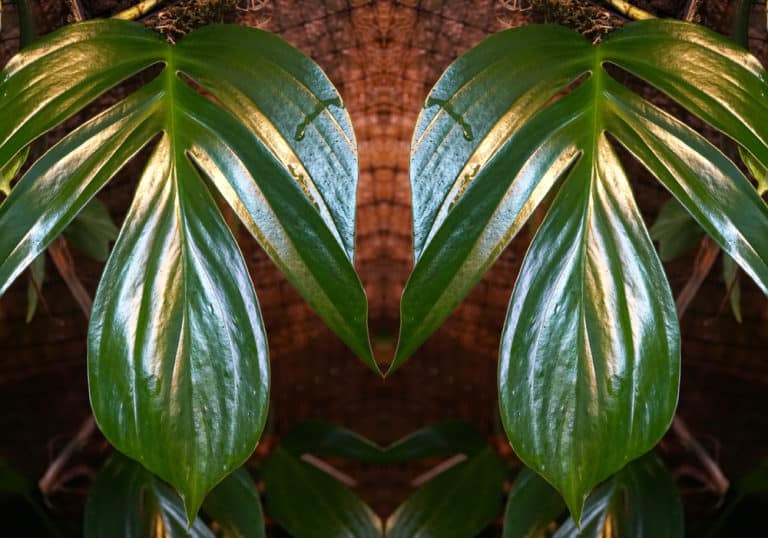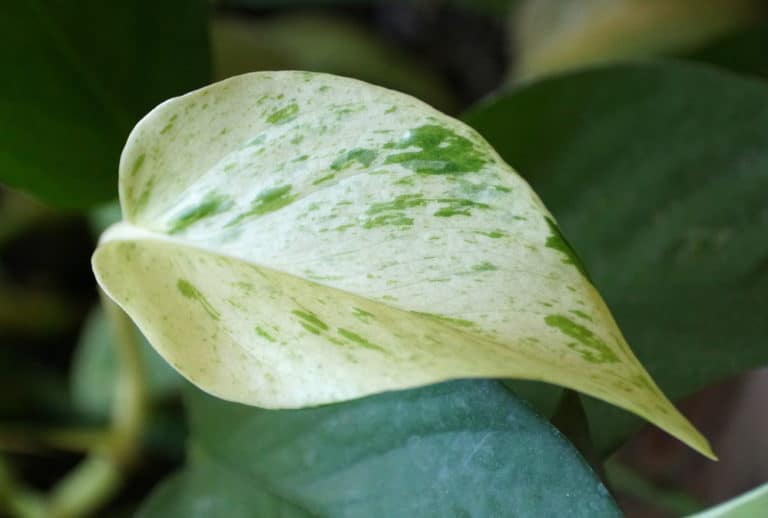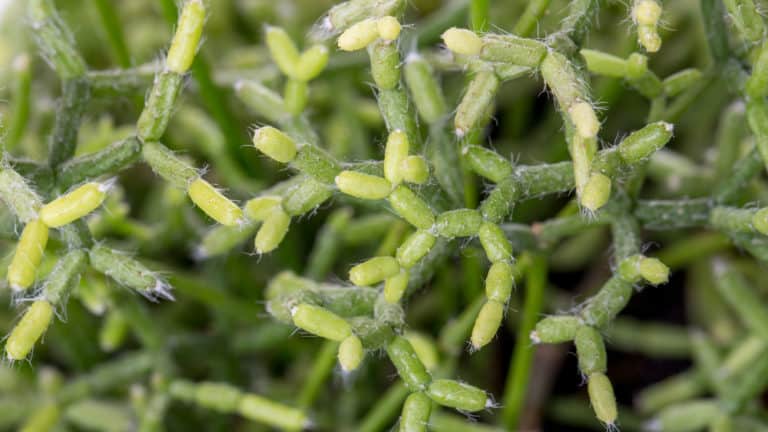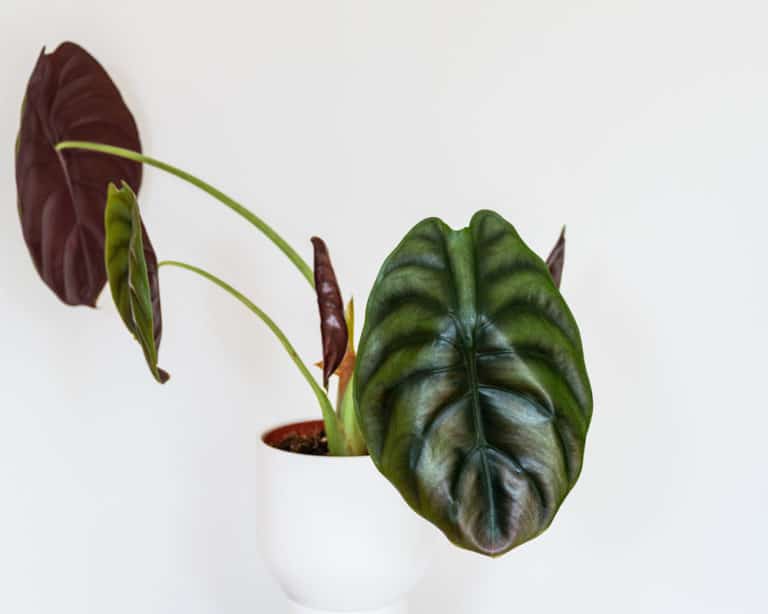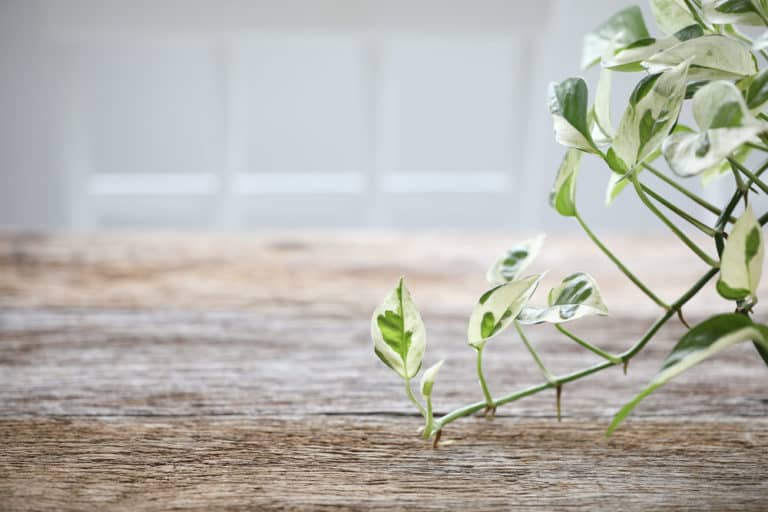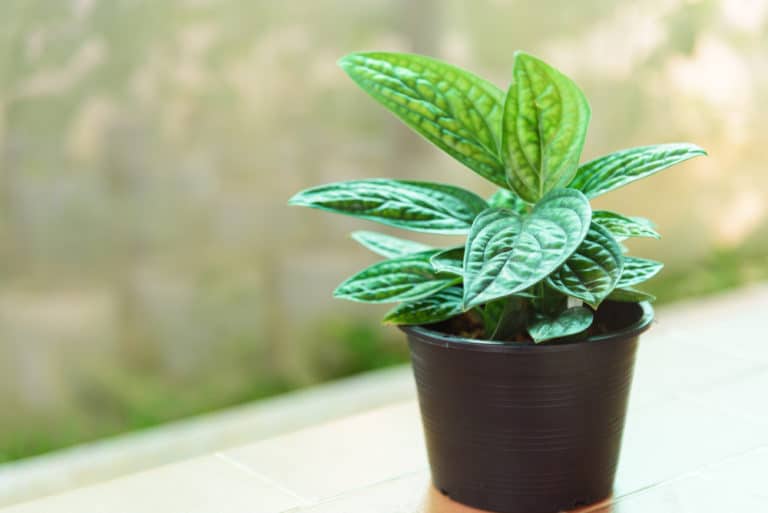Curio Radicans ‘String of Bananas’ Care Guide (2024)
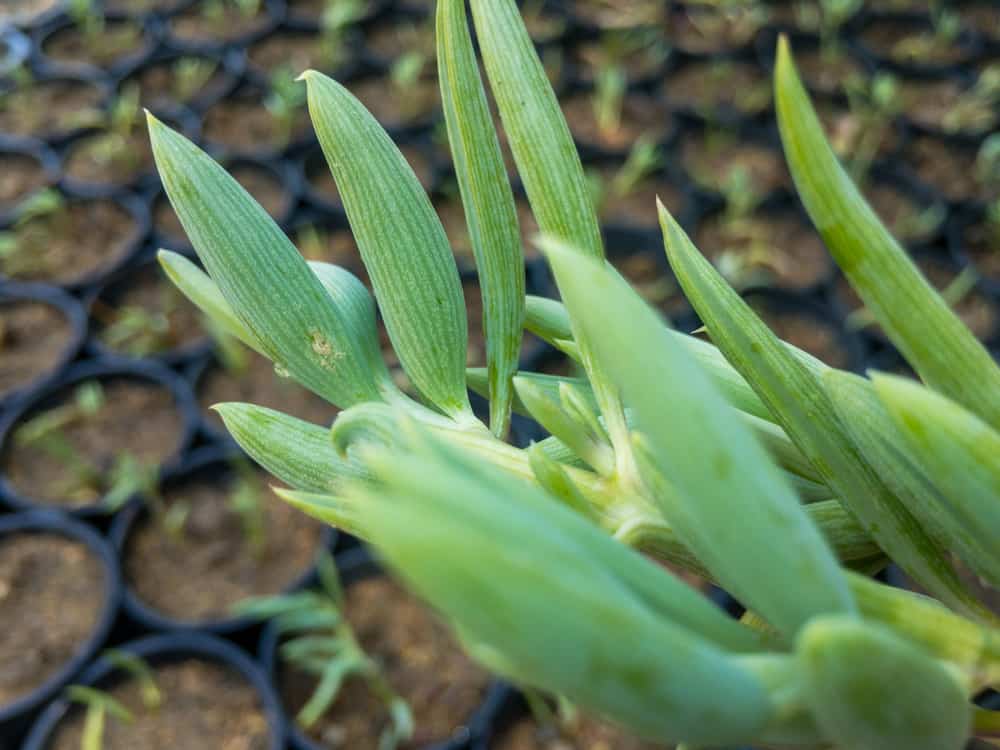
String of bananas is an intriguing succulent vine that is incredibly easy to care for and will add an interesting texture to your indoor garden.
While this subtropical plant is now called Curio radicans, it was previously known as Senecio radicans. It grows fast and makes an excellent hanging plant indoors.
| Scientific Name | Curio radicans |
| Common Name | String of Bananas |
| Light | Bright sunlight |
| Watering | Water when soil is dry |
| Temperature | 70 to 80ºF (21 to 25ºC) |
| Hardiness Zone | 10 to 12 |
| Humidity | 40% |
| Soil Type | Loose, quick-draining |
| Soil pH | 6.6 to 7.5 (mildly acidic to neutral) |
| Fertilizing | Once every 2 months in the growing season |
| Repotting | Every 2 to 3 years |
| Pruning | Beginning of the growing season |
| Propagation | Root in soil |
| Toxicity | Toxic to humans and pets |
| Mature Size | Trailing stems to 3 feet long when grown indoors |
| Bloom Time | Late winter, early spring |
What’s Unique About String of Bananas?
The string of bananas plant is native to the arid subtropical regions of South Africa. It’s closely related to the more common string of pearls, and is an interesting hanging plant with a bit of a quirky look,
String of bananas plants are one of the easier succulents to grow, rewarding you with quick-growing vines perfect for a sunny window.
If you are growing string of bananas in a tropical or subtropical climate, it can be used to cover a rocky stretch of ground to soften the landscape.
Indoors or out, it’s likely to bloom in late winter, producing tiny flowers with a light cinnamon scent.
String of Bananas Care
In the arid region of southern Africa where Curio radicans originates, it grows in sandy and rocky soil in the bright sun.
This makes string of bananas plant care remarkably low-maintenance; not only is it used to full sun, but it also will grow best with infrequent watering.
Your Curio radicans care is simply giving it a warm, sunny spot with dry soil and annual fertilization.
Light
In the semi-desert habitat where it evolved, Curio radicans is used to at least 6 hours of bright sun a day.
In your home, string of bananas light requirements are ideally for bright direct light, or anywhere from 20,000 to 50,000 lux.
Indoors, you can best meet Curio radicans light needs in an east, west, or south-facing window with lots of ambient light.
Your only concern should be exposing your Curio radicans to too much full sun at the hottest part of summer, when it might get burned.
If all you have is a northern exposure, you will need plant lights to give it adequate light.
Watering
The best way to describe string of bananas watering is not much!
It is used to dry and sometimes drought conditions in its native habitat, where it rarely rains in winter, and maybe twice weekly in summer, but with little accumulation. That’s why it has succulent leaves that store water.
Only water Curio radicans when the soil is almost completely dry, soaking the pot in a pail to make sure the water gets fully absorbed.
Then drain off all excess water before setting it back in its saucer. You must never leave it in standing water.
Your Curio radicans will remind you of its watering needs if you wait too long, as its leaves will start to wrinkle as it uses up its water stores.
Temperature
In its native home, Curio radicans is used to average daytime highs from 79 to 91ºF (26 to 33ºC), with lows ranging from 46 to 66ºF (8 to 19ºC).
In your home, a good string of bananas temperature range is between 70 to 80ºF (21 to 25ºC), at least during their growing season.
In winter when it is dormant, you can lower the temperature for Curio radicans to 50-55ºF (10-13ºC). Close to a window in cold weather should be fine.
Curio radicans has some temperature tolerance as low as 35ºF (1.5ºC), but its hardiness is not sufficient to survive freezing temperatures.
Humidity
Depending on the season, the humidity in Curio radicans’ native habitat can be anywhere from 22 to 58%.
Because of its succulent leaves, string of bananas humidity requirements in your home are pretty basic, with the ideal humidity for Curio radicans being around 40%.
That humidity level should easily be achievable without any extra effort on your part.
Actually, humidity that is too high is actually damaging for your Curio radicans, as it can cause foliage to rot and fall off.
If you live in a humid region, be very careful to not water your string of bananas until the soil is quite dry.
Soil
Your string of bananas soil must be very loose and well-draining, as it grows in the wild in sandy, rocky soil.
The best pH level for Curio radicans is 6.6 to 7.5, or mildly acidic to neutral.
Ordinary potting soil will not provide enough drainage for your Curio radicans.
You can buy suitable soil for Curio radicans; both a succulent or cactus blend will work fine. It’s even better to add a handful of pumice to improve drainage even more.
However, you may make your own soil mix from half potting soil, and a quarter part each of pumice and perlite.
Fertilizer
You do not need to use any string of bananas fertilizer at all, but a little bit can give your Curio radicans an extra boost.
The best fertilizer for Curio radicans is a very mild organic solution such as fish fertilizer.
A fertilizer ratio of 3-1-2 is best for your string of bananas.
Every 2 months starting in early spring and through the summer will be plenty for your Curio radicans. Too much can actually damage the plant, so don’t assume more is better.
Do not fertilize your Curio radicans at all in the fall and winter when it is dormant.
Potting & Repotting
You should only do string of bananas repotting every 2 or 3 years, as it doesn’t mind its roots getting a little crowded.
However, repotting Curio radicans does give you an opportunity to refresh its soil, so don’t put it off any further than that.
Only increase by one pot size, and select a pot with good drainage holes. A terracotta pot will be perfect, as it will help the soil stay on the dry side. A glazed or plastic pot may retain too much moisture.
Potting should be done in early spring just as its growing season has started.
Pruning
Regular string of bananas pruning will encourage strong, bushy growth and keep your Curio radicans looking its best.
The best time for cutting Curio radicans is in spring at the beginning of its growing season.
You can trim the trailing vines to your preferred length, and new lateral stems will branch out from that point.
Never remove more than a third of the total plant in one growing season to prevent damage to your Curio radicans.
Of course, you should always remove dead or damaged foliage to discourage pests and disease. Cut well above the discolored parts to ensure that only healthy tissue remains.
Propagation
String of bananas propagation is incredibly easy.
The easiest way to propagate Curio radicans is to simply cut a long length of stem, and coil it atop moist soil in a pot. Press it in gently so that it is in good contact with the soil.
Roots will sprout from all along the stem, and will start to send out multiple new trailing vines.
Alternatively, you can take stem cuttings with several nodes. Strip the lower leaves off the cutting, and leave it out for a few days to let the cut end dry out and callus.
Place the cuttings in water or moist soil, and keep them warm and out of the direct sun.
Within a few weeks they should develop new roots and can be planted out.
Common Problems of String of Bananas
You are not likely to encounter a lot of string of bananas problems. The plants are not terribly susceptible to either pests or disease.
Instead, most problems with Curio radicans are the result of poor growing conditions.
If the leaves start to look less than ideal, check into possible causes to nip any issues in the bud.
Pests
The best way to deal with string of bananas pests is by not having any to begin with.
Bugs are less likely to attack a healthy, happy plant, so start by growing it properly.
You can also do regular sprays of neem oil or insecticidal soap to deter any insects from landing on your Curio radicans.
Spider mites prefer the dry conditions that the string of banana thrives in, so look out for webs and yellow bumps on the leaves. You can rinse them off in the shower.
Mealybugs gather together in cottony clumps to suck the sap. Use a spray with rubbing alcohol to kill them.
Scale insects latch onto stems and leaves and look like brown bumps. You can scrape them off or use rubbing alcohol to remove them.
Diseases
You are really not going to run across many string of bananas diseases, especially if you water it properly.
You may, however, see root rot if you have let your Curio radicans sit in wet soil, as this fungal disease thrives when the roots cannot breathe.
You aren’t going to pull out the root ball to inspect it on a regular basis, but if you start to see yellowing leaves and rotting stems, it’s time to check.
If the roots are turning black and smelly, you need to cut off all parts that have been affected, and replant your Curio radicans in fresh, porous soil in a new pot.
From then on, only water the soil when it is almost dry, and never let it stand in water.
Growing Problems
More commonly, you may have growing problems when it is not given the ideal conditions for healthy growth. You can usually save your sick plant by simply improving those things.
If your Curio radicans is dying at the base, it’s probably a case of over or underwatering. If the problem is too advanced, you’re best off starting new plants from stem cuttings.
While the string of bananas loves lots of sun, if the leaves are turning brown, it may be getting too much, especially in summer.
Shriveled leaves can indicate that the soil is too dry, or that there’s been a sudden upward change in temperature.
If the stems of your Curio radicans are reaching upward instead of trailing down, they are trying to get more light.
Toxicity of String of Bananas
Curio radicans is toxic to humans and animals, although it is classed as only having minor toxicity.
All parts of the plant, including the sap, contain Pyrrolizidine alkaloids, which in small doses cause minor issues, although large amounts can seriously affect liver function.
Growing a string of bananas plant in a home with children or pets should be approached with caution.
For Humans
Curio radicans is mildly toxic to humans, although children are at more risk than adults.
Your main risk would be exposure to the sap causing a rash, as it is an irritant. If you get some on yourself while handling your string of bananas, rinse it off.
Children, however, are naturally curious creatures and are sometimes liable to eat things that they shouldn’t. Unfortunately, the intriguing shape of the leaves of Curio radicans may be irresistible to a toddler.
If your child does eat a leaf, they may develop diarrhea and vomiting. While it’s best to phone a medical professional for advice, you can probably handle any symptoms on your own.
For Pets
Pets are more at risk of serious consequences from ingesting Curio radicans foliage.
If your cat or dog has eaten some of the leaves and is drooling excessively, or has vomiting or diarrhea, you can probably manage the symptoms on your own. It’s more unpleasant rather than life-threatening.
However, long-term consumption can impact the liver. Cats are more likely to try eating the leaves, which can fall to the floor from time to time.
If you find them eating the leaves on an ongoing basis, it’s best to either find a place for your string of bananas that is off-limits to pets, or choose a non-toxic plant instead.
String of Bananas Appearance
The generous vines that spill over the edge of a hanging basket are a major appeal of the string of bananas appearance, similar to its close relative string of pearls.
The banana-shaped leaves give this subtropical vine its common name, and the small, fragrant flowers that bloom in late winter add an extra bonus.
Foliage
The foliage of string of bananas resembles, not surprisingly, small green bananas. They grow evenly spaced along the long, trailing stems, creating a lush look.
Each leaf is blue-green in color, with 20 to 50 lengthwise striations around its circumference. It also has one clear window which allows more light to penetrate into the interior for improved photosynthesis.
The thick, succulent leaves curve upward, each up to 1 inch or more long, and a third of an inch in diameter.
The leaves are prone to fall off when the vines are disturbed, so it’s best to leave them alone as much as possible.
Flowering
String of bananas flowering occurs in late winter and early spring on plants that have been given ideal growing conditions.
That includes a dormancy period in early winter, with temperatures around 60ºF (15ºC) and very dry soil.
The Curio radicans flower is small and delicate, with fluffy white or cream petals and yellow or mauve anthers. They grow in clumps of 3 or 4.
Blooms last for about 6 weeks before fading, at which time you should cut them off.
When it is blooming, you will detect a gentle cinnamon fragrance which is very pleasant. However, like the rest of the plant, these flowers are toxic.
Size and Growth
The size of string of bananas, as well as its growth rate, depends on whether it is grown indoors or outside, according to your climate region.
An indoors Curio radicans usually has trailing stems up to 3 feet in length, with a moderate growth rate.
Outdoors in a tropical or subtropical zone, the stems can quickly grow to 6 feet long, whether they’re spilling over a wall or growing as a dense mat of ground cover.
Indoors they will do best in direct light, while in the more intense light conditions outdoors they do best with some protection from the full sun.
String of Bananas Fragrance
While the evergreen foliage of Curio radicans does not have a scent, you will notice a pleasant
string of bananas fragrance when the delicate white flowers bloom in late winter and early spring.
It smells like cinnamon, and while it is not extremely strong, you will be able to smell when fairly close to your string of bananas.
You may wish to have a chair nearby so that you can enjoy it while you read or eat.
The light nature of the fragrance is ideal for a small apartment where a more overpowering scent would be too much to bear.
Suggested Uses for String of Bananas
The cute appearance and lush vines of Curio radicans give you lots of options when using it indoors or outside.
If you have an overwhelmingly bright south window, you can use hanging planters of string of bananas to create a living curtain of greenery.
While it’s not suited to the high humidity of a bathroom, a small half-bath can easily accommodate this plant without taking up precious floor space.
Outdoors, you can screen a less than ideal view from a balcony with a row of hanging planters.
If you live in a frost-free region, Curio radicans can be used as a spreading ground cover across a rocky expanse where little else will grow.
FAQ
What is string of bananas?
The string of bananas plant is an evergreen subtropical vining perennial native to the dry regions of southern Africa, where it grows as a spreading ground cover.
How to identify string of bananas?
The string of bananas plant has 3 foot long trailing stems with 1 inch succulent leaves shaped like miniature green bananas, with occasional small white flowers.
How to care for string of bananas?
The string of bananas plant should be grown in bright direct to indirect light in a warm environment with low to moderate humidity and watered infrequently.
How to grow string of bananas indoors?
The string of bananas plant can be grown as a hanging plant in a bright location, watering it only when the soil is dry, with infrequent fertilization.
How to grow string of bananas outdoors?
The string of bananas plant can be grown outdoors all year in zones 10 to 12, usually as a ground cover on rocky or sandy soil.
How fast does string of bananas grow?
The string of bananas plant has a fast growth rate outdoors, and a moderate to fast growth rate when grown indoors, depending on light conditions.
How tall does string of bananas grow?
The string of bananas plant will grow trailing stems up to 3 feet long when grown indoors, while an outdoors plant can reach up to 6 feet.
How to make string of bananas grow faster?
The string of bananas plant will grow at its maximum speed when it is placed where it can receive optimal light conditions of very bright light without being burned in full sun.
How to stake string of bananas?
The string of bananas plant is usually grown as a trailing plant in a hanging basket, but if desired it can be trained up a moss pole or on a trellis.
How to pot string of bananas?
The string of bananas plant must be planted in very sharp, well-draining soil, in a terracotta pot with drainage holes to keep the soil on the dry side.
How to revive string of bananas?
The leaves of the string of bananas plant may start to wrinkle when the soil is completely dried out, but soaking the pot in water will usually bring them back.
Why is my string of bananas dying?
If the crown of your string of bananas plant is either rotting or withering, it’s had too much water or not enough. You may need to root stem cuttings and start again.
Why is my string of bananas drooping?
Your string of bananas plant is naturally a trailing plant, with stems that hang down over the edge of the pot. Unless the leaves are wrinkling up, you have nothing to worry about.
How cold can string of bananas tolerate?
The string of bananas plant can tolerate low temperatures that remain above freezing for short periods, and actually prefers winter temperatures around 55 to 60ºF (13 to 15ºC).
How to get rid of pests on string of bananas?
Most insect pests can be deterred from your string of bananas plant by regular applications of insecticidal soap or neem oil sprays on the foliage.
Is string of bananas toxic to cats?
Yes, the string of bananas plant is toxic to cats. Small doses can cause vomiting or diarrhea, while continued ingestion can lead to liver damage.
Is string of bananas toxic to dogs?
Yes, the string of bananas plant is toxic to dogs. While just one or two exposures may result in a bout of vomiting and diarrhea, ongoing consumption can impact the liver.
Is string of bananas toxic to children?
Yes, the string of bananas plant is toxic to children. Eating some of the leaves can lead to gastrointestinal distress such as vomiting and diarrhea, and should be avoided.
Is string of bananas toxic to humans?
Yes, the string of bananas plant is toxic to humans. Handling the plant without gloves can cause a rash from exposure to the irritating sap.
Does string of bananas have a scent?
Yes, the string of bananas flower has a light, pleasant scent similar to cinnamon when it blooms in late winter. The foliage, however, has no fragrance.

